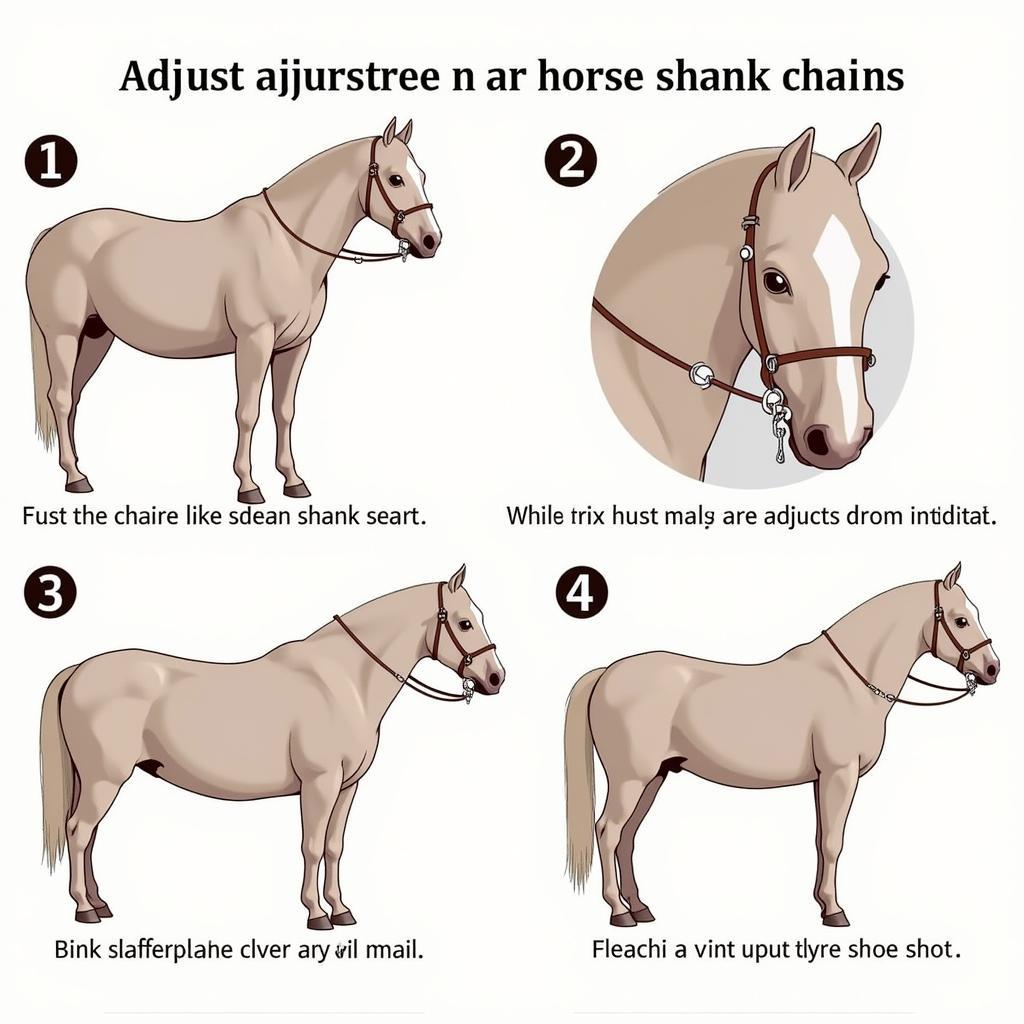The Horse Shank Chain, a tool often debated in the equestrian world, is a linked metal chain attached to the shank of a bit. It serves to add pressure and leverage, influencing a horse’s response to cues. While its traditional use is rooted in western riding disciplines, understanding the horse shank chain’s purpose, effects, and ethical implications is crucial for any horse person.
Decoding the Horse Shank Chain
A chain shank horse is essentially an extension of the bit shank. When engaged, it applies pressure to the horse’s poll (the area behind the ears) and chin groove. The severity of this pressure is determined by the length and weight of the chain, the type of bit it’s attached to, and how the rider uses their hands.
 Types of Horse Shank Chains
Types of Horse Shank Chains
The Purpose of a Shank Chain
Contrary to some misconceptions, the shank chain is not meant to inflict pain. When used correctly, it acts as a communication tool, refining cues and encouraging specific head and neck positions. Here’s a closer look at its intended purposes:
- Increased Leverage: The chain amplifies the rider’s rein aids, allowing for subtle cues that the horse can readily interpret.
- Enhanced Communication: The pressure from the chain provides clear signals to the horse, guiding them into desired movements and transitions.
- Head Position Control: Different chain positions and adjustments can encourage a horse to lower, flex, or yield at the poll.
Types of Horse Shank Chains
Several types of shank chains are available, each offering a distinct level of pressure and effect. Understanding these differences is vital for choosing the right chain for your horse and riding discipline.
- Flat Link Chains: These are the most common and generally considered milder. The flat links lie relatively flat against the horse’s jaw, distributing pressure over a wider surface area.
- Round Link Chains: With round links, the pressure points are more concentrated, resulting in a sharper feel. These are typically used on older, more experienced horses or those requiring stronger cues.
- Combination Chains: These combine flat and round links to offer a balanced level of pressure and communication.
Using a Horse Shank Chain Responsibly
The use of a horse shank chain is a topic of much debate. While it can be a valuable training tool, it’s essential to prioritize the horse’s well-being and ensure its use is ethical and humane.
 Adjusting a Horse Shank Chain Properly
Adjusting a Horse Shank Chain Properly
Here’s what responsible use entails:
- Proper Fit: The chain should lie flat in the chin groove, with enough slack to allow for movement without pinching or binding.
- Skilled Hands: Using a shank chain requires a high level of horsemanship and finesse. Harsh or inconsistent hands can cause pain and confusion.
- Gradual Introduction: Horses new to a shank chain need time to adjust. Introduce it gradually and pair it with positive reinforcement.
“A shank chain is not a shortcut for good riding,” says renowned horse trainer Sarah Williams. “It should only be used by experienced riders who understand the mechanics of pressure and release and can apply it with sensitivity and timing.”
When to Avoid Using a Shank Chain
While shank chains can be helpful tools, there are situations where they are not appropriate:
- Young or Green Horses: Young horses are still learning to respond to basic rein aids and can be easily overwhelmed by the pressure of a chain.
- Horses with Injuries: Using a chain on a horse with an existing injury or sensitivity in the mouth, jaw, or poll can exacerbate the issue.
- Riders Lacking Experience: Using a shank chain requires finesse and experience. Riders who haven’t mastered basic rein aids should avoid using them.
Alternatives to Shank Chains
For those seeking alternatives to shank chains, there are several options available:
- Snaffle Bits: A bridle for a horse often includes a snaffle bit, a mild option suitable for most horses, particularly those in training.
- Curb Bits Without Chains: Some curb bits are designed to function without a chain, offering leverage through their mouthpiece and cheek piece design.
- Mechanical Hackamores: These provide leverage through pressure points on the nose and chin, eliminating any pressure in the horse’s mouth.
Conclusion
The horse shank chain is a powerful tool that requires careful consideration. By understanding its purpose, effects, and ethical implications, horse owners can make informed decisions about its use. Remember, responsible horsemanship always prioritizes the horse’s well-being.
 Alternative Bits and Equipment
Alternative Bits and Equipment
Do you have any experience using horse shank chains? Share your thoughts and questions in the comments below!
Need help choosing the right equipment for your horse? Contact us at Phone Number: 0772127271, Email: [email protected], or visit our address: QGM2+WX2, Vị Trung, Vị Thuỷ, Hậu Giang, Việt Nam. Our 24/7 customer service team is always ready to assist you.